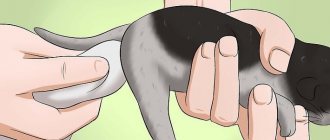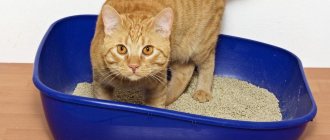4720Administration
Every cat needs water treatments from time to time. For this reason, it is important to know how to teach a kitten to bathe. If a four-legged pet gets used to water from early childhood, caring for it will become much easier and more convenient. Often, the owner’s mistakes lead to the kitten experiencing fear before bathing, which is reinforced and persists for life. As an adult, such a pet will always be afraid to swim. Teaching a cat to bathe is more difficult than teaching a kitten. Only special cats naturally love water and tend to bathe themselves, so attention should be paid to training them for such a procedure.
Possible hypothermia and fear of being overheated
Cat fur has a specific structure.
The fur provides her with impeccable protection. A pet's fur coat plays the role of thermal insulation, due to the fact that air is retained with the help of fur hairs and a protective layer is formed. Water that gets on a cat's fur displaces the air membrane, and the fur loses its ability to insulate heat. A wet cat quickly freezes and cannot warm itself until it dries. A cat that gets into water can get sick.
That is, the cat is not afraid of water, it avoids the possible negative consequences that await it as a result of getting wet. They cannot shake water off their fur and it is very unpleasant for them to get wet.
In hot weather, cats also do not want to bathe, and the reason again has to do with insulation. Losing this ability, wool cannot protect the animal from heat and sunlight.
Cleansing with dry shampoo
This is the simplest, most gentle way. What are its advantages over the traditional one? Using dry shampoo will not make your cat nervous, and your hands will remain intact.
You can use this product once every six months. In this case, the procedure will not become more complicated than regular combing. But you should know that if it is carried out on a carpet, then it will be quite difficult to clean it from the powder. After rubbing the shampoo a little into the animal's fur, comb it thoroughly.
“Tactics” for training a cat to use the bathroom
Before teaching a cat not to be afraid of water, you need to overcome all the accompanying discomfort. Carry the animal into the bathroom in your arms; if the cat does not strain, try turning on the water for a short time. Calm your cat down, let him know that he is protected, but be prepared, the sound of running water can throw the cat into panic.
Try putting the animal in a dry bath; most likely, the pet will immediately run away, but this is only the first stage. Agree with your pet, do not try to wet the fur or force the cat not to be afraid, forcing events will only add to the hassle. Gradually, patiently, agreeing to the animal’s conditions and that’s the only way!
Naturally, it is easier to accustom a kitten to water; the little one who unconditionally trusts you will accept or at least tolerate water procedures after 3-4 “training swims”. It is difficult, sometimes impossible, to train an adult cat. If your pet doesn't go outside, it's easier to give him a quick bath than to torment him for months of training.
Why don't cats like water?
No, this is not a whim or character flaws, but an instinctive fear. In nature, a wild cat will go into the water based solely on survival instincts. There are exceptions, for example, tigers are swimmers and fishermen who can easily endure water procedures due to the water-repellent structure of their fur. It just so happens that more than 80% of domestic cats hate bathing, while the remaining 20% tolerate it. From the point of view of cat psychology, purrs do not like water because their fur quickly gets wet, and water, especially with shampoo, dries out delicate skin.
If you hope to “twist” your pet and bathe it “somehow”, give up the illusion; without washing the fur, you are risking the health of your ward. In addition, true fear provokes animals to desperate actions, fighting charms and torn clothes are provided to you, and after that, wet slippers and torn wallpaper as moral compensation for the “abuse”.
How to teach a cat to bathe without unnecessary stress
Half the success is quality preparation, especially when it comes to training an adult cat that has not yet experienced the “joys” of water procedures. You will need:
- 2 shallow but wide basins for water.
- Comb with large rounded teeth.
- Capacity for pouring up to 250 ml in volume.
- Large bedspreads or sheets.
- Several thin ones and one bath towel.
- Gloves and thick clothing to protect the body.
- Shampoo, if necessary.
- It’s very good if there is a “second pair of hands” to help.
- One of the basins is filled completely, the second so that the water barely covers the bottom. Water temperature 38.5–39 degrees.
- You and your assistant dress in ammunition and gloves. The bathroom floor is completely covered. Any “force majeure” will be accompanied by turmoil in which it is easy to slip.
- Carefully and slowly, holding the animal from above, lower the cat's paws into a basin without water. The animal will tense up and start shaking with its paws - we calm it down, pet it, hold it (there will be attempts to escape), do not try to sit it down or lay it down.
- After wetting the sponge with water, run it over the animal’s fur and calm the pet again.
- As a result, all the wool should be wet. The exception is the muzzle and ears. The second step is to lather the wool, if necessary.
- We comb the “fur coat” with a comb. In general, combing is necessary to remove foam if you use shampoo, but when training, we do not deviate from the algorithm.
- We pour the cat over from a small container several times.
- We blot the wool with thin towels and wrap it in a bath.
- Take your time, but don’t delay either, the procedure is not pleasant and the sooner it ends, the better.
- Repeat the procedure no more than once a month; even bathing with clean water partially washes off the protective layer of fat from the animal’s skin.
Everyone knows that she really dislikes bathing and avoids this procedure in every possible way, probably believing that she licks herself quite well. But after amazing walks there is sometimes an urgent need to wash it. How often should you wash your cat and what can you do to teach it to bathe?
It is often not recommended to bathe cats, since their natural fatty lubricant is washed out by shampoos, while the skin no longer shines so gracefully, the skin dries out, and becomes susceptible to various diseases and infections. But before an exhibition or show you have to bathe her, and also if she comes in dirty from the street. Skin diseases also require cleanliness.
Let's look at how to teach a cat to bathe. In general, cats do not like to bathe, but only some breeds agree to categorically accept such an exotic procedure for themselves. Despite the fact that cats are difficult to train, if you teach them to bathe from a young age, they will gradually get used to it.
First, you need to pour just a little water and wait until the cat climbs in to inquire what is there in the basin? The water should be warm and pleasant, but without violence. And let him only wet his paws. You can also take the kitten in your arms and a small bowl, put one paw there, then the other. The next day, wet all paws. It’s good to put your cat’s favorite toy in the basin. This will also be an incentive to be curious and play.
We looked at how to gradually accustom a cat to water. You can let your cat watch you bathe yourself, showing that it is not at all dangerous. Perhaps your pet will be interested. But still, cats are cats, and if you can’t train them, then there should be no violence under any circumstances. It is difficult to convince a cat, and if she is stubborn, then it is already impossible to change her.
It should be noted that there are special shampoos for cats. They are the ones who best create the acid-base balance and cause the least harm to the skin.
We suggest you read: Fluffy cat breeds and care features
After you teach the kitten to wash, the bathing process itself should be as follows. You put the cat in a basin filled with warm water, the temperature of the cat's body, then take a mug and slowly water it, wetting the skin, and be sure to talk in a gentle voice. Then pour a little shampoo onto your hand and rub it.
At first, I was a supporter of the idea that everything should be done only of one’s own free will, even such an unpleasant event as swimming. Therefore, with my first cat, I prepared for it very carefully. I bought a small basin in which I planned to bathe the kitten (he was 2 months old at the time), and bought waterfowl toys.
And at first I took some water into the basin, threw everything in there and called the cat. As it turned out, she was not psychologically afraid of water. That is, she climbed into the basin in an attempt to get toys. Only when she came into contact with water, she was visited by a terrible state of disgust: she immediately pulled her paw back and licked it.
As a result, the cat, realizing that the toys were floating for a reason, but in nasty water, walked around them in circles, wondering how to get them without contact with the liquid. The idea, of course, never ended. We carried out this procedure several times - the result was the same. The cat likes touching water and never started.
And our first bath did not happen when I planned, that is, when the animal fully adapts to the water (how naive I was!), but when the need arose - she got her bottom dirty in the toilet. Well, at this point I forgot about all the psychological tricks and, grabbing the cat in my arms, ran to the bathroom. The cat struggled terribly, screamed, scratched me, and then took a couple of hours to come to its senses.
In general, all my psychological techniques went down the drain. After that, I became a supporter of the idea that when you don’t want it, you may not need it, but if you really need it, then you have to take the bull by the horns.
What am I talking about? You may be lucky and your cat loves water. Then the method of water training that I first tried with my cat will suit him. Or, perhaps, you will be less lucky, and then you will swim with screams and fights. Then the cat will either have to almost never bathe, or, on the contrary, try to do it regularly in order to accustom it to the procedure.
My cat, by the way, is one of those who can even endure wet fur without contact of her paw pads with water, is not afraid of splashes, and she climbs into the water with curiosity if I bathe. If this is the case for you, you can try bathing on a grated tray to allow the water to drain underneath.
Another point is at what age you started bathing your kitten. If this happens after 3-4 months, then training will be more difficult. The easiest way to teach this is from “young claws,” that is, from two months. Many people do not recommend bathing a cat until six months old, but if you want everything to go more or less smoothly, you need to instill in your cat from childhood the idea that bathing is normal. Moreover, a teenage cat and an adult cat, bathing for the first time, can cause serious injuries to the owner.
Also, try to pay attention to what your cat is actually afraid of. Perhaps he is not afraid of wet fur and paws, but is bothered by the noise of the shower? Then bathe him in a full bath to avoid splashing and noise. Or maybe, on the contrary, he is afraid of drowning in a full bath? Then it is better to prefer a shower.
Or he doesn’t like wet paw pads - then put a net on the floor and let the water flow down. In general, look for an individual approach to minimize stress and inconvenience and do not act like the owners of the cat in the video below, who do not seem to care about the comfort and emotions of their pet: instead, they film it, doing everything to make the cat feel bad.
Unfortunately, no matter how caring the owners are, there are also cases when cats flatly refuse contact with water to such an extent that even two adults cannot keep them in the bathroom. After all, there are purely physiological reasons for cats to be afraid of water. Firstly, they don’t really need these procedures, because they wash themselves.
We suggest you read: Flea control products for cats, which one is better, what to choose
Secondly, wet fur smells and interferes with hunting, i.e. Wetting a cat is associated with the risk of going without dinner. Thirdly, under the wool there is an air and lipid layer, as well as its own microbiome, which perform, among other things, the function of thermal insulation and support local immunity, and after bathing all these functions are disrupted.
If your cat hates water and causes real carnage while bathing, I recommend paying attention to dry cat bathing products without water. These are special shampoos and sprays. Yes, they clean the coat worse than traditional shampoos and water, but it’s still better than nothing or constant wars with bloody consequences.
The author of the article, Ekaterina Yugosh, is the editor of the “Murkotiki” website, a journalist with a felinological education (a felinologist is a specialist who studies cats). She received her felinological education according to the WCF (World Cat Federation) system. She raises a Scottish Straight cat and a Highland Fold cat, as well as a Miniature Schnauzer dog. Her areas of in-depth interests include zoodietology and zoopsychology.
Since the appearance of cats, it has been generally accepted that there are no more terrible enemies for them than dogs and... Water. Cats are afraid of water, perhaps even more than dogs. And it is the water that they bypass the farthest side. However, most owners of these beautiful pets have problems due to their fear of water. For example, preparing a cat for an exhibition requires water treatments.
How to wash representatives of different breeds
Some types of cats require an individual approach to hair care. For purebred pets, it is advisable to use specialized shampoos. White animals require the use of bleaching detergents. Long-haired babies, Persian and Siberian for example, are bathed more often than others, once every 2 months. Shorthaired Scots or British - once every 6 months.
Persian kittens are bathed more often than others
Features of bathing sphinx kittens
Hairless pets differ from their counterparts not only in their exotic appearance, but also in the rate of contamination of the skin. Due to the fact that they do not have a protective coat, they need to be bathed frequently. Veterinarians recommend washing hairless kittens once every 3-5 weeks. For water treatments, Ms.Kiss “Graceful Sphinx” and Doctor VIC shampoos are suitable. To clean your pet's head, you need sanitary napkins specially designed for cats.
Sphynx cats sweat a lot. This leads to excessive contamination of the skin, especially in the folds.
The skin of Sphynx cats gets dirty faster than other breeds.
Bathing a kitten is a responsible and energy-consuming procedure. Knowing the basic rules of a bath day, this process can be turned into an exciting event. A pet’s love for washing largely depends on the owner, so you should patiently instill in your baby a culture of water hygiene.
Bacteria and dirt
Wet cat fur collects a lot of dust and dirt. A pet's warm fur is ideal for the proliferation of harmful bacteria and microorganisms. When an animal licks itself, these pathogenic bacteria and fungi enter the animal's body. The cat intuitively feels that it begins to feel bad after water procedures and avoids them.
Hygiene products, the use of which makes the skin of a furry animal dry and more susceptible to any infection, also have a bad effect on the condition of the skin. Therefore, cats should be bathed only when necessary. The optimal water temperature for water procedures for seals should be close to room temperature.
A special feature of cats is that they mainly need to drink at night. Owners must ensure that the pet has free access to water.
Cats fed dry balanced food need more water. Sometimes veterinarians advise moistening the food before feeding.
What should you not do while swimming?
As you can imagine, bathing a cat, a procedure that takes only a few minutes, is quite difficult for both the animal and its owner. Therefore, it is necessary to minimize possible irritants:
- Do not open the tap at full capacity.
- The shower should not be turned on at full power.
- Do not use dog shampoo or dishwashing detergent to wash your pets.
- There is no need to pour shampoo from the bottle directly onto the coat, especially dry hair.
- It is strictly forbidden to stuff the animal's ears with cotton - it can cause serious irritation.
It's real!
Firstly, I would like to note that there are cat breeds that have a love of water in their blood. They are not afraid of her, on the contrary. They happily jump into the water and swim in it, as if they were natural swimmers. But, fortunately or unfortunately, there are very few such cat breeds.
Some cats are not too afraid of water. They can contemplate it, but they still won’t risk going and swimming. However, for example, having settled somewhere near a lake, a contemplative cat is not at all opposed to catching fish with the help of its claws. Accustoming such cats to water will not be difficult.
Most cat owners can confidently confirm that their pet loves to watch the movement of water, look at it and even touch it with its paws. But if the cat needs to be bathed, then problems appear instantly.
Firstly, it is necessary to remember that the most important reason why a cat refuses to bathe is fear. They can and do swim. But they don't want to. And it is precisely this reluctance and fear that must be fought first. But you shouldn’t do everything by force. After all, coercion will cause not only aggression in the cat, but also fear of its own owner.
Why teach a cat to swim?
One of the main questions that pet owners may have is why it is necessary to teach their cat to swim. And there are several options here. Firstly, cats are clean animals, but situations often occur when water procedures are simply necessary for them. In particular, this concerns the appearance of fleas and various skin diseases in cats. In addition, when a cat walks along the street, it can become very dirty and then water procedures simply cannot be avoided. Moreover, if the cat has long hair, then in this case it is impossible without using shampoo and combing. And everyone knows very well that cats that are not accustomed to water do not like this procedure very much. Therefore, it is advisable to accustom a cat to water, at least for purely hygienic purposes. Secondly, a cat’s ability to swim can protect it from various dangerous situations. If, for example, the owners quite often take their pet with them to the dacha or on vacation near a pond, then the ability to swim may be useful to him in case of unforeseen circumstances. Everyone understands perfectly well that cats are very curious animals and have well-developed hunter instincts. Often these features lead them into the most unpleasant and life-threatening situations. Thirdly, swimming can be an excellent exercise for the animal. It has a great effect on the condition of the animal’s ligaments, improves its tendons and joints. In addition, for those cats that tend to gain excess weight, this activity can be the only way to avoid obesity and related diseases. Therefore, we can say with certainty that swimming is beneficial for cats at any age.
How to teach a cat to swim at home?
Unlike dogs, cats are animals with a special disposition. It’s not for nothing that they say that cats walk on their own. They are difficult to train, so owners should introduce them to water at home. Moreover, it is strictly forbidden to do this with desperate screams and hasty actions. Cat owners should be prepared for the fact that practicing such skills in a cat will require good endurance and maximum patience. Otherwise, you can simply discourage your pet from complying with the requirements and water procedures. To begin with, in order to accustom your cat to water, you should not pour a full bath of water and throw your pet into it. This will make the animal lose its fear and begin to panic. It’s much better to start getting acquainted with water procedures with an ordinary basin, which everyone probably has. You need to pour a little water into it, which will only cover the bottom of the basin. Then you need to lower the cat into the basin and let him get used to his new environment. Let your pet taste the water, walk on it, and perhaps even lie in it. To make the animal as comfortable as possible, you can put your favorite toy at the bottom of the basin. Over time, the amount of water in the basin can be increased and at the final stage there should be so much that the cat can reach the bottom with the tips of its paws. At the same time, you should always put a toy in the basin so that, if necessary, the animal has to swim for it. Then it will be possible to carry out water procedures in a completely filled bathroom.
Cat swimming in a natural body of water: is it possible?
Many owners of pets such as cats are wondering: is it possible to teach a cat to swim in a natural body of water? The answer to this question is yes. A cat can and should be taught to swim in such bodies of water. But here you will have to make a lot of effort and show maximum endurance. And it is advisable to do this only after the animal has successfully completed the young fighter course at home. To learn to swim in such conditions, you must initially choose the moment when your pet is in a great mood. To begin with, the animal needs to be given a little time to explore the new environment. Next, the cat’s favorite toy will come in handy again. It needs to be thrown into a body of water, first at a minimum distance, and then further and further away from the shore. If the toy suddenly does not arouse interest in the cat, then you can use your pet’s favorite treat for training. Due to the characteristics of cats, this method is often much more effective.
More information about how to teach a cat to swim will be discussed in this video. Leave your wishes under the material.
How to bathe a cat correctly
Much of a pet’s behavior is related to the first time he took the water procedure. You cannot bathe a cat while holding it by force. You need to treat her fears and whims with kindness and patience, because she is a cat, a wayward representative of her wild descendants, who loves to live and walk on her own; you shouldn’t be rude to her.
You can accustom your cat to water procedures with patience and love.
- First, you need to accustom your pet to the sound of pouring water. You can take her in your arms, stand in the bathroom and slowly turn on the water. This should be repeated daily, adding a stream of water each time. The kitty will get used to the sounds of the bathroom and will not react aggressively when she is taken there for a bath.
- The bath itself seems so cold, unusual and dangerous to the cat. You can help the cat first get used to a small basin placed in a familiar place for the pet. When the cat is no longer afraid of the bowl of water, it can be moved to the bathroom.
It is necessary to use methods of caressing, tasty treats, and convey a playful meaning to the procedure. Gradually, the time spent in the bathroom should be increased to 20 minutes. The animal develops a pleasant feeling associated with this environment; it will associate water and a bath with play and tasty morsels.
- When the cat is already accustomed to the sounds of water, to the bath, you need to pour warm water into the bath up to the animal’s toes and lower his favorite toy into it. Mostly cats are delighted with this game.
- It is correct to place a towel on the bottom of the bathtub. This way the pet will not slide along the bottom and will stay firmly on its paws.
- You cannot use hygiene products intended for humans to bathe a cat; they are unacceptable for cats’ delicate sense of smell.
We suggest you familiarize yourself with: Breeds of white geese, Italian white geese breed
For bathing, you should purchase special products for cats, which strictly take into account the characteristics of their delicate skin. The use of such products will not harm the natural balance of the animal’s skin.
- After your pet has taken a bath, he needs to be wrapped in a pre-heated towel so that he does not feel cold and does not get sick.
- Cats should be accustomed to water procedures from an early age so that there are no problems associated with them in the future.
Bathing should be done without any fuss. The pet must first be watered with small streams of water so that the cat gets used to it. The detergent must first be warmed in your hands and then applied to the wool. It is necessary to apply the product to the body with careful and smooth movements. Do not allow foam to get into your eyes.
Patience and love for your pet must be shown in every action you take towards it. Having established a relationship with his beloved pet, the owner acquires the most faithful and devoted friend for life.
How to make addiction easier
You need to wash in a shallow basin standing on the floor. Little kittens experience an instinctive innate horror at the sight of high sides of the bathtub and pouring water. They associate them on a subconscious level with flooding, which means they are a command to escape. It’s good if the cat managed to get acquainted with the basin, sniff it, and play in it before bathing.
Bath a kitten from the age of 4 months
Before the process itself, put the kitten in a basin, let it get used to it and run around side by side. Pour non-chlorinated water into it, no more than 5-7 cm. The most comfortable temperature is 38-40 degrees. Place the kitten in the basin. Quickly wet his head, being careful not to get water into his ears and nose.
You need to be patient, do not scold or shout at the baby while bathing; it is better to calm him down with kind words if he meows loudly, showing fear. Do not delay the procedure.
After bathing, the baby should be wrapped in a warm towel, thoroughly blotted, and encouraged: milk, a favorite treat, a toy. If you are shaking, it means you are freezing, you need to change the towel to a dry and warm one, hold it in your arms, and calm it down. Use only special, hypoallergenic shampoos.
Note! Kittens aged 1-3 months should not be bathed unless absolutely necessary. The optimal age for the first wash is 4 months.
If the baby gets dirty in the cat litter box, it is better to wipe it with wet wipes or wash only the paws, but do not bathe the baby completely.
The main thing is patience
Everyone knows that by nature cats are very cautious creatures. And it will not be possible to quickly accustom them to water. It is necessary to accustom your pet to water procedures gradually, carefully and for a long time. Therefore, first you need to be patient.
You can start training by getting the cat used to at least the flowing stream of water from the tap. This stage of training will take a little time. And, as soon as the cat understands that water is not such a terrible thing, you should move on to the second stage.
You will need a container. For example, a basin. You need to fill the basin with water. At least 1/3. Then you should take the cat and put it in the basin. It is very important that the water temperature is slightly above 40 degrees. If the cat's favorite toy is thrown into the water, then perhaps this stage of training will be much easier.
So, for the first time, as we mentioned, you should fill 1/3 of the basin with water. So that only the pet’s paws are in the water. As soon as the cat begins to get used to the water, after a few days you can increase the amount of water in the basin. And then you can gradually fill the bath until the cat begins to feel confident in the water.
Interesting facts about waterfowl cats
The Turkish Van is considered a special waterfowl breed. Their front paws are equipped with special membranes that allow them to quickly row in the water, and their fur repels dirt and moisture well and practically does not get wet.
The Turkish Van is an excellent swimmer
The Turkish Van is an unsurpassed hunter; he chases not only rodents, his attention is attracted by various insects: beetles, butterflies, grasshoppers. If you need a fishing companion, he will be only too happy. He will happily spend time in nature, chasing a school of small fish in the shallows.
However, the fishing cat is rightfully considered the record holder for fishing. The wild swimming cat lives in southeast Asia (Indochina, Ceylon). Another name is speckled. Its weight can reach 15 kg. The cat has powerful jaws. It is unlikely that it would occur to anyone to tame an aggressive animal.
The front paws of the fishing cat, like those of the Turkish Van, are equipped with membranes. They prevent the claw plates from retracting and help in diving and fishing. With such equipment, it is not scary to swim long distances in search of prey. Swimming is his strong point, so the hunter lives near swamps, small lakes, and slow rivers flowing through tropical forests.
Cat fisherman with prey
What to do after swimming?
After bathing your cat, you need to dry it thoroughly with a towel, since cats get very cold after such a water procedure, especially if the apartment is not very warm. Many owners consider it lucky if the cat allows him to be warmed in a towel for at least five to ten minutes. Then the animal will most likely break free and begin to lick its coat on its own.
Pre-cover all surfaces where your pet can sit down to lick with towels. They will absorb moisture, and your sofas and carpets will remain stain-free. If your cat continues to tremble violently within five minutes, try to dry it with a hairdryer to avoid catching a cold or even pneumonia.
You already know how to bathe a cat. Now it’s worth talking about combing the fur. When the cat stops licking his fur, pick him up and brush him with a wide-toothed brush. After bathing, the coat becomes very brittle, so combing must be extremely careful.











